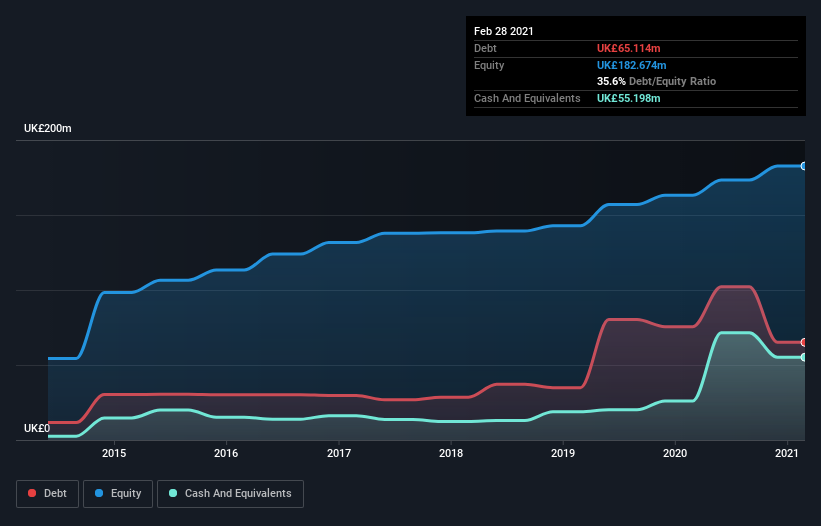Warren Buffett famously said, ‘Volatility is far from synonymous with risk.’ It’s only natural to consider a company’s balance sheet when you examine how risky it is, since debt is often involved when a business collapses. Importantly, First Derivatives plc (LON:FDP) does carry debt. But the more important question is: how much risk is that debt creating?
What Risk Does Debt Bring?
Debt assists a business until the business has trouble paying it off, either with new capital or with free cash flow. Ultimately, if the company can’t fulfill its legal obligations to repay debt, shareholders could walk away with nothing. While that is not too common, we often do see indebted companies permanently diluting shareholders because lenders force them to raise capital at a distressed price. Having said that, the most common situation is where a company manages its debt reasonably well – and to its own advantage. When we think about a company’s use of debt, we first look at cash and debt together.
Check out our latest analysis for First Derivatives
What Is First Derivatives’s Net Debt?
The image below, which you can click on for greater detail, shows that First Derivatives had debt of UK£65.1m at the end of February 2021, a reduction from UK£75.5m over a year. However, it also had UK£55.2m in cash, and so its net debt is UK£9.92m.

A Look At First Derivatives’ Liabilities
We can see from the most recent balance sheet that First Derivatives had liabilities of UK£69.9m falling due within a year, and liabilities of UK£97.5m due beyond that. On the other hand, it had cash of UK£55.2m and UK£78.3m worth of receivables due within a year. So it has liabilities totalling UK£33.8m more than its cash and near-term receivables, combined.
Since publicly traded First Derivatives shares are worth a total of UK£625.0m, it seems unlikely that this level of liabilities would be a major threat. Having said that, it’s clear that we should continue to monitor its balance sheet, lest it change for the worse.
We use two main ratios to inform us about debt levels relative to earnings. The first is net debt divided by earnings before interest, tax, depreciation, and amortization (EBITDA), while the second is how many times its earnings before interest and tax (EBIT) covers its interest expense (or its interest cover, for short). Thus we consider debt relative to earnings both with and without depreciation and amortization expenses.
While First Derivatives’s low debt to EBITDA ratio of 0.47 suggests only modest use of debt, the fact that EBIT only covered the interest expense by 6.6 times last year does give us pause. But the interest payments are certainly sufficient to have us thinking about how affordable its debt is. It is just as well that First Derivatives’s load is not too heavy, because its EBIT was down 28% over the last year. When it comes to paying off debt, falling earnings are no more useful than sugary sodas are for your health. There’s no doubt that we learn most about debt from the balance sheet. But it is future earnings, more than anything, that will determine First Derivatives’s ability to maintain a healthy balance sheet going forward. So if you want to see what the professionals think, you might find this free report on analyst profit forecasts to be interesting.
Finally, while the tax-man may adore accounting profits, lenders only accept cold hard cash. So it’s worth checking how much of that EBIT is backed by free cash flow. Over the last three years, First Derivatives recorded free cash flow worth a fulsome 93% of its EBIT, which is stronger than we’d usually expect. That puts it in a very strong position to pay down debt.
Our View
First Derivatives’s conversion of EBIT to free cash flow suggests it can handle its debt as easily as Cristiano Ronaldo could score a goal against an under 14’s goalkeeper. But the stark truth is that we are concerned by its EBIT growth rate. Looking at all the aforementioned factors together, it strikes us that First Derivatives can handle its debt fairly comfortably. Of course, while this leverage can enhance returns on equity, it does bring more risk, so it’s worth keeping an eye on this one. When analysing debt levels, the balance sheet is the obvious place to start. But ultimately, every company can contain risks that exist outside of the balance sheet. To that end, you should be aware of the 2 warning signs we’ve spotted with First Derivatives .
If you’re interested in investing in businesses that can grow profits without the burden of debt, then check out this free list of growing businesses that have net cash on the balance sheet.
Promoted
If you’re looking to trade First Derivatives, open an account with the lowest-cost* platform trusted by professionals, Interactive Brokers. Their clients from over 200 countries and territories trade stocks, options, futures, forex, bonds and funds worldwide from a single integrated account.
This article by Simply Wall St is general in nature. It does not constitute a recommendation to buy or sell any stock, and does not take account of your objectives, or your financial situation. We aim to bring you long-term focused analysis driven by fundamental data. Note that our analysis may not factor in the latest price-sensitive company announcements or qualitative material. Simply Wall St has no position in any stocks mentioned.
*Interactive Brokers Rated Lowest Cost Broker by StockBrokers.com Annual Online Review 2020
Have feedback on this article? Concerned about the content? Get in touch with us directly. Alternatively, email editorial-team (at) simplywallst.com.

